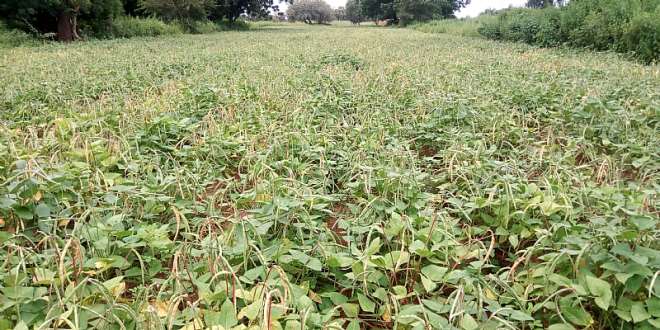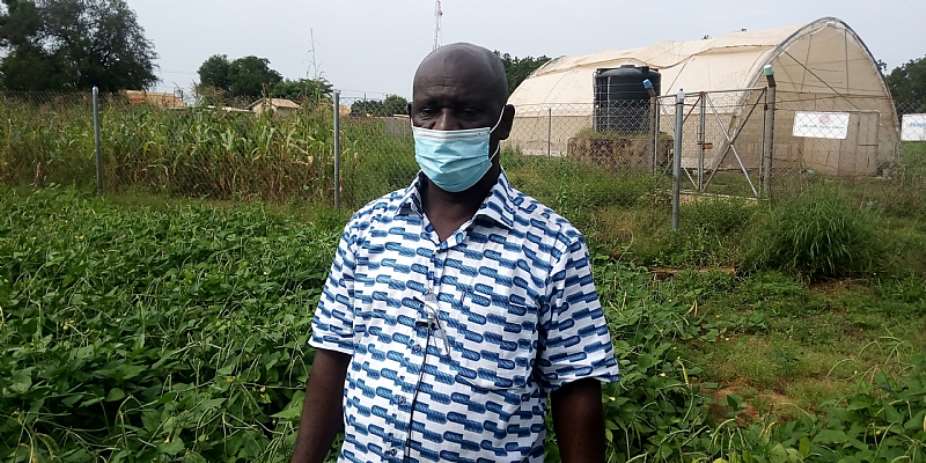The Manga Station of CSIR-SARI has engaged cowpea farmers along the Fumbisi valley in the Builsa South District in Upper East Region and other stakeholders in the cultivation of improved Cowpea varieties using residual moisture.
The programme was organized under the United States Agency for International Development (USAID) sponsored Innovation Lab for Legume Systems Research (ILLSR) project, a CSIR-SARI – University of California Riverside collaborative research project.
The Lead Scientist of the project at CSIR-SARI, Dr. Francis Kusi, speaking on the sideline of the programme, told the media that, one of the objectives of the project is to reach out to the under privilege, the marginalized, the deprived, less empowered farmer groups, communities or ethnicity when it comes to access to agricultural technologies and resources to increase their productivity.
Justifying the involvement of the cowpea farmers in Fumbisi, Dr. Kusi said, they contribute significantly to the production of cowpea in Ghana yet they lack access to adequate proven technologies to increase their production and productivity which he said probably could be due to the fact that the farming communities in Fumbisi are hard to reach by scientist and other stakeholders.
The farmers agreed with Dr. Kusi’s observations and added that Fumbisi is known nationwide for the production of rice, but many more production of other crops also take place there which do not receive adequate support like the rice production.
They were therefore much appreciative to Dr. Kusi, CSIR-SARI and ILLSR project for introducing improved varieties to them. According to Dr. Kusi, Fumbisi is the source of a landrace cowpea variety called ‘Alancash’ in Fumbisi which has attractive large seeds size and white seed quote colour.
He added that, although the seeds of ‘Alancash’ is attractive, the variety is unimproved and its photoperiod sensitive and for that matter, the farmers can produce it once in a year between October and December.
He, therefore, introduced the Fumbisi farmers to two improved early maturing, photoperiod insensitive, striga and aphid resistant cowpea varieties.
The two varieties, Wang Kae and Kirkhouse Benga, he said, unlike their landrace could be produced and harvest every 60 days (2 months) which, means between May and December each year, they can do at least 3 production cycles to generate more income.
The Builsa South District Crop officer, Abdulai Amadu expressed the hope that with the introduction of the two improved varieties under the Planting for Food and Jobs (PFJ) programme, the farmers can have access to the improved seeds at a subsidized price and adapt to the new variety.
He stated that the floods, as usual, this year, left in their wake large deposits of residual moisture along the valleys of Fumbisi, which is conducive for the cultivation of cowpea for the last quarter of this year.
At the end of the exercise, the about 80 participants most of whom were women farmers, were optimistic that, they will have enough cowpea to content with by the close of December this year.









 2024 elections: Resign if you can't be faithful to party - Sagnarigu NDC PC desc...
2024 elections: Resign if you can't be faithful to party - Sagnarigu NDC PC desc...
 Five arrested, remanded over alleged murder of two police officers at Transacco
Five arrested, remanded over alleged murder of two police officers at Transacco
 Tax exemptions better than incentives for churches – Tax Analyst tell Bawumia
Tax exemptions better than incentives for churches – Tax Analyst tell Bawumia
 Transport Minister sues Law Platform Editor for defamation
Transport Minister sues Law Platform Editor for defamation
 Voter registration: Police arrest NPP Treasurer for Mpohor for registering minor
Voter registration: Police arrest NPP Treasurer for Mpohor for registering minor
 "This nonsense must stop" — Lawrence Tetteh vows to march to Jubilee House over ...
"This nonsense must stop" — Lawrence Tetteh vows to march to Jubilee House over ...
 2024 elections: “If indeed you stand for peaceful elections the time is now for ...
2024 elections: “If indeed you stand for peaceful elections the time is now for ...
 I have the attributes to be president of this country — Bernard Monarh
I have the attributes to be president of this country — Bernard Monarh
 Cecilia Dapaah saga: ‘Turf war’ between AG, EOCO, OSP indicates they’re not ‘cor...
Cecilia Dapaah saga: ‘Turf war’ between AG, EOCO, OSP indicates they’re not ‘cor...
 Ghana will become the first African country to embrace blockchain-powered gover...
Ghana will become the first African country to embrace blockchain-powered gover...
